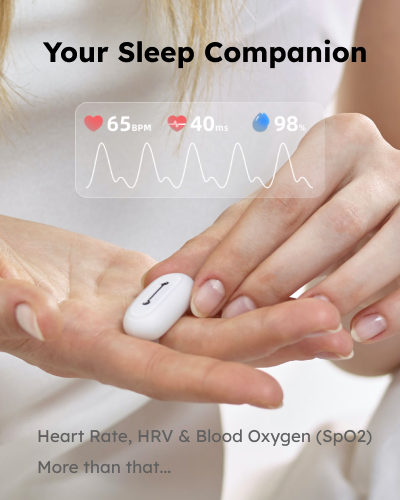REM Sleep Functions: Why are They Important to You? – Sleepon

Have you felt you’re slowly losing memories?
This could be due to a lack of good sleep, especially Rapid Eye Movement (REM) Sleep.
During the first part of the night, we spend most of our time in deep sleep (also called slow wave sleep). This is where our brains process information and memories. The second half of the night is spent in Rapid Eye Movement (REM) sleep, where one of the functions during this stage is for our bodies to repair themselves.
Therefore, we’ll cover REM Sleep functions today to help you better understand the importance of it. You can also get a sleep tracker to better understand your sleep patterns.
What is REM Sleep?
Rapid Eye Movement (REM) Sleep, which was first defined in 1953, is a sleep stage where we dream and develop our memories, learning and problem solving.
Originated in the brain stem, electrical and chemical activities are regulated in this phase.
It’s also associated with random rapid movement of eyes and low muscle tone throughout the body.
When does REM Sleep happen?
Typically, REM Sleep happens around 90 minutes into the sleep cycle.
It’s part of our whole night’s sleep, along with the other four non-REM Sleep stages by happening after them.
Our full night of sleep involves these five sleep stages multiple times, where the period of REM Sleep recycles once every 90 to 120 minutes.
Each stage of sleep happens in the following sequence:
Stage 1 of non-REM Sleep (Light Sleep)
The first stage of sleep is called light sleep. During this phase, your body temperature drops slightly. You may often wake up during this stage because the brain sends signals to your muscles telling them to move.
During this stage, there is muscle tone present in the skeletal muscles. You also tend to breathe at a regular rate at this stage.
Stage 2 of non-REM Sleep (Light Sleep)
Stage 2 follows Stage 1 and usually means deeper sleep, but it’s still considered as light sleep. You are less likely to get woken at this stage.
During this stage, your heart rate and breathing regulate, your body temperature goes down, your eye movement slows down until it completely stops, your muscles tend to relax.
Stage 3 of non-REM Sleep (Deep Sleep)
Even though stage 3 is considered as deep sleep, it still acts as the transition between deeper sleep (stage 4) and REM sleep (stage 5), in which your body temperature starts to rise.
At the same time, your brain waves slow down in stage 3 where your muscles relax and breathing slows even more. It’s also harder to wake up and we might feel at loss of direction if the alarm rings. Research has used loud noises that are over 100 decibels but still couldn’t awake participants that were in deep sleep.
Stage 4 of non-REM Sleep (Deep Sleep)
In stage 4 of non-REM sleep, we are in deep sleep where our brain waves further slow down. In this stage, your body starts tissue repair and growth, same as your muscles, because your blood flow increases to the muscles. Besides that, the hormone for growth is released.
What is it like during REM Sleep?
You may experience multiple changes in your body and mind during this phase:
- Rapid eye movements. The name of this phase is from the observation that scientists did in the 1950s that a person’s eyes moved rapidly from side to side.
- Fast breathing. During REM Sleep, your breathing can become fast and irregular.
- Fast heart rate. You may experience a fast heart rate to nearly the waking level.
- Increased blood pressure. If you use a sleep tracker during the night, you’ll realize the blood pressure is raised along with other vitals that are faster, like breathing and heart rate.
- Brain activity. Your brain is highly active during REM Sleep, similar to when you’re awake. Your brain waves become more variable. Besides that, your brain consumes more oxygen in this stage as well.
- Paralyzed movement. Many muscles in this stage become paralyzed. Researchers have hypothesized that this is a protective measure, meant to stop you from acting out your dreams.
- Muscle twitches. From your face to your limbs, they may experience muscle twitches. Scientists say the muscle twitches can help certain areas of your brain to be active, which in turn leads to motor learning and development.
- Dreaming. Dreaming is more likely to happen in this stage, and your dreams can be long as well as emotional and vivid, like they’re happening in real life.
Why is REM Sleep so important?
We all know sleep is very vital to our wellness and overall functioning. REM Sleep, as part of the entire sleep process, functions of REM Sleep include emotional regulation, dreaming, memory consolidation, and brain development.
- Emotional regulation.A 2015 study indicated that REM Sleep may regulate emotional arousal, which also links to the involvement of memory.
- Dreaming. Most of your dreams occur during REM Sleep. Although dreaming can happen during non-REM Sleep as well, according to Neuroscience 2nd Edition, people in an REM Sleep experiment are awakened from REM sleep recall elaborate, vivid, and emotional dreams, whereas others awakened during non-REM sleep report fewer dreams.
- Memory consolidation. Forming memories and processing learned knowledge is another essential role of REM Sleep. One study suggests memories are retained during REM Sleep. A 2016 study found healthy adolescents that have sleep deprivation could increase the risk of forming false memories.
- Brain development. This is extremely important among children. Data has shown that up to 50% of sleep is REM Sleep during early childhood. With that said, while a child’s brain and body are fast-growing, it’s when they spend most of their time in REM Sleep. Research has found such evidence in animals.
How much REMA Sleep do you need?
As an adult, the amount of time spent in REM Sleep varies from person to person. Scientists all agreed that 7-9 hours of sleep is needed among adults, yet they haven’t concluded about the average time of REM Sleep; some say adults need around 2 hours of REM Sleep each night.
However, REM Sleep is more common among infants and children. For instance, newborn babies typically spend 8 hours a day in REM Sleep. Since this sleep stage may be responsible for brain development, that explains why infants require higher levels of REM Sleep than adults.
What if you don’t get enough REM Sleep?
Many studies showed REM Sleep deprivation can cause memory loss and hard to learn since REM Sleep deprivation interferes with your brain’s ability to generate new cells.
Besides that, lack of REM Sleep can also:
- Reduce coping skills. A lack of REM Sleep may decrease your ability to tell the difference between threatening and non-threatening stimuli and respond accordingly. During the day, you may also have difficulty in concentrating.
- Develop obesity. REM Sleep deprivation disrupts your quality of sleep, which can be linked to obesity, and furthermore, diabetes
- Affect childhood development. Among children, not be able to have enough REM Sleep can affect the development of vision and also result in having behavioral issues later in the future.
- Influence pain tolerance. Not having enough REM Sleep can increase your pain sensitivity. With that said, you may be unable to tolerate pain for longer times compared to a person that isn’t REM deprived.
How to Get More Quality Sleep?
One of the first steps to improving your sleep is to make sure you’re getting enough quality sleep. This means going to bed at a reasonable hour (ideally between 9 p.m. and 11 p.m.), waking up naturally without an alarm clock, and avoiding caffeine and alcohol before bedtime. You should also avoid napping during the day because it disrupts your body’s natural circadian rhythm.
If you want to get more quality sleep, try going to bed earlier than usual. Research shows that people who go to bed at 10 p.m. tend to wake up around 7 a.m., while those who go to bed at midnight wake up between 8 and 9 a.m.

You can also try to track your sleep to better understand your sleep patterns, in order to improve quality sleep. Sleep trackers, like Go2Sleep, can be your fit, by providing rich data with reasonable pricing. Named as the best value sleep tracker of 2022, Go2Sleep collects data of heart rate, blood oxygen level, AHI (apnea-hypopnea index) to give you a basic understanding of your sleep. It also gives you a sleep score so you can have a straight sense of your sleep health.
References
REM sleep: Definition, functions, and the effects of alcohol
What is REM Sleep and How Much Do You Need?
REM Sleep: What It Is and Why It Matters | Sleep Foundation
The Possible Functions of REM Sleep and Dreaming – Neuroscience – NCBI Bookshelf
The role of REM sleep theta activity in emotional memory
What is REM Sleep? – The Sleep Doctor
Best Sleep Trackers of 2022 | Sleep Foundation
The role of rapid eye movement sleep for amygdala-related memory processing – ScienceDirect
The Possible Functions of REM Sleep and Dreaming – Neuroscience – NCBI Bookshelf
ALL ARTICLES
Subscribe Us
403A, Building A2, Zhihui Park, Fuyong Street, Bao'an District, Shenzhen, Guangdong, China
Products
Company
Copyright © SLEEPON. All rights reserved.
SLEEPON keeps both Sleeponhealth and Sleepon.us due to the brand upgrading. We promise to provide the same products and service in both sites.








Leave a Reply